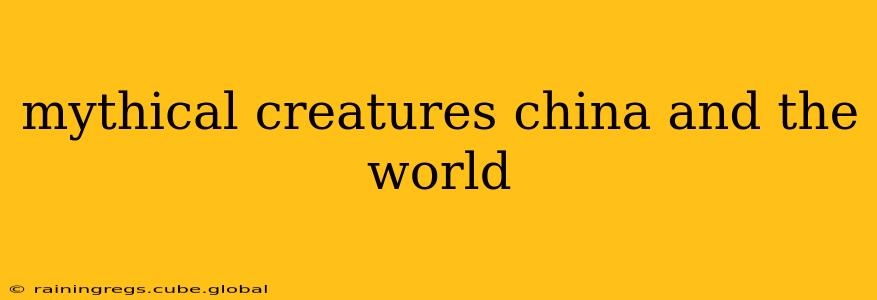For centuries, humans have spun tales of fantastical beings, populating our myths and legends with creatures both terrifying and enchanting. From the majestic dragons of the East to the mischievous sprites of the West, these mythical creatures reflect our deepest hopes, fears, and understanding of the world around us. This exploration delves into the captivating world of mythical creatures, focusing on the rich tapestry of Chinese mythology and comparing them with other globally recognized beings.
What are some of the most famous mythical creatures from China?
China boasts a vibrant pantheon of mythical creatures, each with its own unique story and symbolism. Among the most famous are:
-
Dragons (龙, lóng): Unlike the Western image of a fire-breathing beast, Chinese dragons are benevolent symbols of power, wisdom, and good fortune. They are associated with water, rain, and prosperity, often depicted with serpentine bodies, scales, and antlers. Their presence in art, literature, and festivals underscores their cultural significance.
-
Phoenix (凤凰, fènghuáng): The phoenix is a legendary bird representing rebirth, grace, and immortality. Unlike the Western phoenix which rises from ashes, the Chinese phoenix is often depicted in vibrant colors and symbolizes harmony and feminine power.
-
Qilin (麒麟, qílín): This gentle, horned creature resembles a deer, ox, or lion and is a symbol of peace, prosperity, and good governance. The qilin is considered a divine messenger and its appearance is said to herald a period of peace and harmony.
-
Nüwa (女娲, nǚwā): Although not strictly a creature, Nüwa, the creator goddess, holds a prominent place in Chinese mythology. She is credited with molding humanity from clay and mending the sky after a great cataclysm, making her a powerful figure representing creation and resilience.
-
Bai Ze (白澤, báizé): This incredibly knowledgeable creature is said to have known the names and characteristics of all the mythical beasts and monsters in existence. This ability made it a valuable resource for emperors seeking knowledge and protection.
What are some of the most famous mythical creatures from other parts of the world?
While Chinese mythology is rich and diverse, numerous other cultures have their own unique creations:
-
Griffin (Greece): This majestic creature, with the body of a lion and the head and wings of an eagle, represents strength, power, and royalty. It often guards treasures and sacred places.
-
Unicorn (Various Cultures): Found across various cultures, including Europe and Asia, the unicorn symbolizes purity, grace, and innocence. Often depicted with a single, spiraling horn, it’s a creature of legend and often linked to healing powers.
-
Kraken (Scandinavia): This enormous sea monster, capable of sinking ships, represents the immense and unpredictable power of the ocean. Its size and destructive capabilities make it a creature of fear and awe.
-
Sphinx (Egypt): With the body of a lion and the head of a human, the sphinx embodies wisdom, power, and enigmatic mystery. Often guarding tombs and temples, it challenges those who seek to pass.
-
Banshee (Ireland): A wailing female spirit often associated with death and misfortune, the banshee serves as a harbinger of doom.
What is the significance of mythical creatures in different cultures?
Mythical creatures often serve as powerful symbols reflecting a culture's values, beliefs, and fears. They provide explanations for natural phenomena, embody moral lessons, and serve as vehicles for storytelling and cultural transmission. For instance, the benevolent Chinese dragon contrasts sharply with the often-malicious dragons of European lore. These differences highlight the diverse ways cultures interpret and interact with the unknown.
How do mythical creatures reflect cultural values and beliefs?
The characteristics and roles of mythical creatures within their respective cultures provide valuable insight into their societal values. The emphasis on harmony and balance in Chinese mythology, reflected in creatures like the qilin and phoenix, contrasts with the more individualistic and sometimes violent nature of creatures found in other mythologies. This difference reveals underlying societal structures and belief systems.
Are there any similarities between mythical creatures from different cultures?
Despite their cultural differences, some striking similarities can be found among mythical creatures across the globe. For example, the recurring theme of creatures that guard treasures or sacred spaces suggests a universal human fascination with the protection of valuable resources. The prevalence of winged creatures, such as dragons and griffins, also suggests a common desire to transcend earthly limitations and reach the heavens.
This exploration only scratches the surface of the vast and fascinating world of mythical creatures. Each culture's unique interpretations contribute to a rich global tapestry of folklore and legend, reminding us of the power of imagination and storytelling to shape our understanding of the world.
